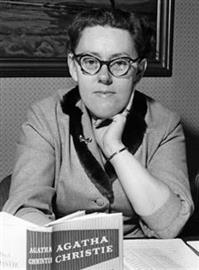What with the current popularity of Scandinavian crime fiction, it is interesting to go back to the roots of the genre there. Maria Lang (1914-1991), the pen name of the Swedish writer Dagmar Lange, published her first crime novel, Mördaren ljuger inte ensam (The Murderer Is Not the Only Liar), in 1949, and went on to become known as "Sweden's Agatha Christie" as she continued to publish prolifically over the next 42 years.
How Christie-like was she, really? It is not easy to judge in English: only three of her novels have so far been translated, although more may follow since Lang is undergoing a revival in Sweden, rooted partly in a new series of television movie adaptations. On the one hand, Lang's mysteries are universally described as belonging to the cosy genre. Her "handsome and pipe-smoking detective" Christer Wijk is assisted in the early books by the young feminist Puck Ekstedt and her charming, muscular fiancee Einar Bure; in some later titles by detective novelist Almi Graan, which, yes, is an anagram of "Maria Lang"! The settings are often traditional Swedish small towns similar to Nora, where Lang grew up; Mördaren ljuger inte ensam takes place on an island retreat, the better to keep all the characters and suspects geographically tight. So there are definitely Christie-like aspects to Lang's work, as well as prefigurement of Murder, She Wrote and Midsomer Murders. It is worth remembering, too, that even a grittier specimen of later Swedish crime fiction, Stieg Larsson's The Girl with the Dragon Tattoo, features its own island.
Christer, Puck, and Einar played by fabulously attractive actors
But Maria Lang was perhaps a little edgier than Dame Agatha. Mördaren ljuger inte ensam invited a bit of controversy because the murder victim was a lesbian sculptress, whose lover also appears in the story. The novel acknowledges sexual difference and apparently treats it sympathetically and not freakishly: Lang "makes a both matter of fact and passionate plea that also homosexual love is real love," one source says. She seems to have been quite comfortable with employing sexual passion as a motivation for murder, which takes cosy one step towards modern.
But not too modern. Lang, a girls' school teacher in her main career, eventually quarreled with the more realism-promoting Per Wahlöö when they struggled for control of the Academy of Swedish Detective Fiction, which Lang co-founded but ultimately walked out on.
"Swedish Agatha Christie" is probably too facile, ultimately (such formulations always are). Maria Lang represents her own approach. Her novels "presuppose a cultured readership," reviewer Irene Scobbie notes; they are soaked in literary and operatic references, and Puck and Einar are both academics. Lang herself wrote opera reviews, and her protagonist Christer Wijk marries a Wagnerian singer later in the series. One starts to see connections form here: Sexual passion is operatic in its intensity, and to have it coursing under the surface of an ostensibly cosy mystery offers something different than what we're used to, perhaps.
The three existing Lang translations-into-English, A Wreath for the Bride, Death Awaits Thee (this one is heavy on the opera), and No More Murders, all date from the Sixties; all have been made newly available for the Kindle and/or the iPad.
Maria Lang
Review of Maria Lang, Mördaren ljuger inte ensam (The Murderer Doesn't Lie Alone)
Death Awaits Thee



No comments:
Post a Comment